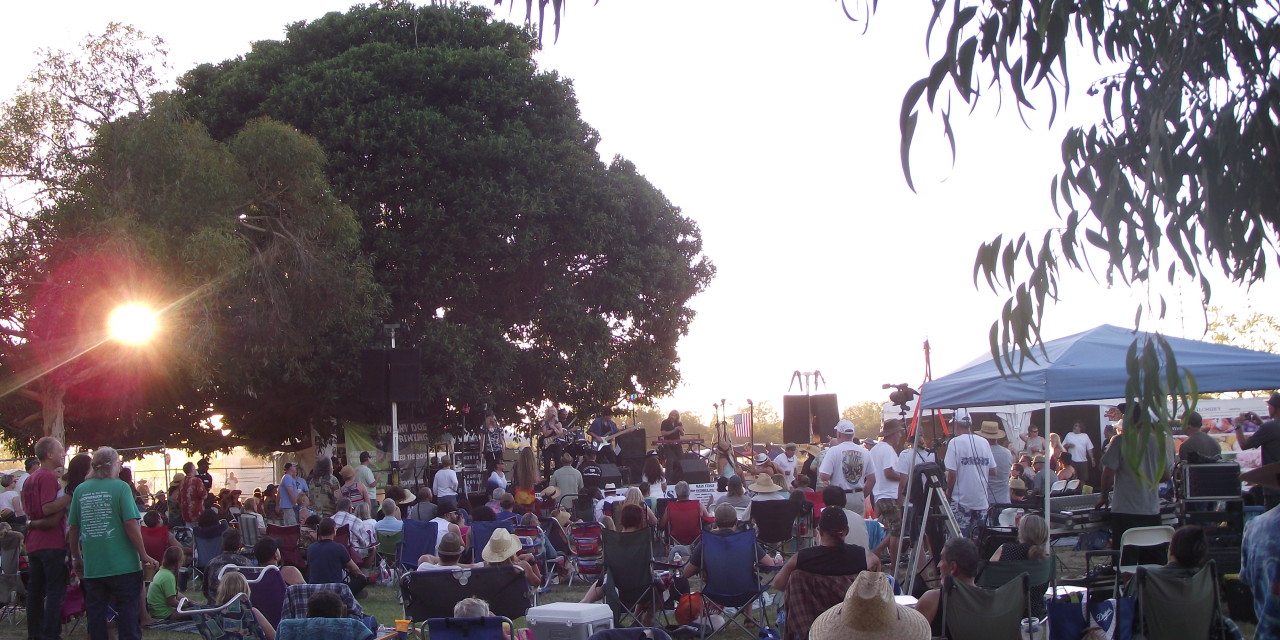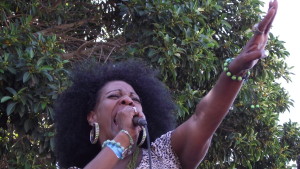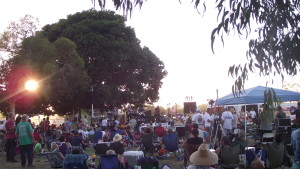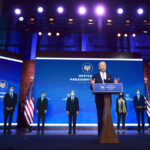Labor Day Weekend, 2015—Long Beach, California
Saturday, September 5th 8am
I wonder if this is what it was like for Robert Johnson after a Friday night barnburner, hobbling back to a rickety shack under the Mississippi sky…It’s too damn early for the blues, I cuss to myself aloud, parking my VW space pod in a lot behind Kohl’s at the Long Beach Towne Center. The sun is shining, it’s hot and getting nothing but hotter and I’m already breaking a sweat.
For me, the landscape is a bit more urban, though entirely not out of tune with the Delta guttural moans. It’s a brisk 5-minute stroll passing by training grounds for the Long Beach Police Department, the source of many a man’s blues in this town. Hellhounds on my trail, I got to keep moving…
The last of this summer’s sun is quickly climbing overhead; it’s gonna be a blazer today. Good thing I packed a bottle of water; no booze on the menu for me. Only the blooze—and a homemade ham/cheese sandwich and green apple. I’m hoping to score a meal voucher later along with my press pass but this is yet to be confirmed.
“I’m looking for Bill Grisolia” I say to a volunteer guiding in vehicles; “do you know where I can find him?”
“Nope” the volunteer responds without looking at me as he waves through an incoming car; “ask Doug.”
Who the hell is Doug? Oh yeah, I remember: Doug is the publicity service guy who sent me the press release to share on all my social media. We’ve never met in person but the internet connects us unlike any other time in human history.
Walking toward some white tents, I recall a more analog time when attending a festival happened through word of mouth. I was living in Bezerkeley when my friend Ezra phoned my landline informing me of Coachella back in ’99 and my roommate Christian and I drove down from the East Bay to the Imperial Valley for the inaugural edition of that particular event.
Times change. Technology changes.
And the New Blues Festival II ain’t Coachella. Perhaps that’s a good thing.
I find Doug sitting at a concrete table under the shade of a tree and introduce myself as a contributing writer for Landscape Latino. He offers me a press day pass (meal voucher not included), smiles big and tells me to “have a good time.”
Simple, so simple. Ain’t it just like the blues.
After picking up my press-colored wristband—and with two and a half hours to kill before the first act—I wander over to the smaller stage which is still being set up: bluesmen are carrying guitars in cases and hauling drum kits; roadies are lugging amps; techies are patching in cables. This set-up appears to be a low-fi do-it-yourself operation: there is nothing luxurious about it, there are no expensive air-conditioned green room tents for divas to hide in while they munch green M&Ms and chug endless bubbly. There is only a simple wooden stage rising low off the ground, surrounded by picnic tables that belong to the park—all encircled by tall shady trees that remain bright green year round. A row of fresh Porta-Potties glistens nearby.
I sit on top of a table and light up a ciggie. Some time to think—about the blues, about life, about the blues in my life. These run deep…so instead I focus my attention to the music and reflect. The first blues album I ever bought was a bootleg live recording of The Chicago Blues Band featuring John Lee Hooker, Sunnyland Slim, Johnny Shines, Willie Dixon and Clifton James performing somewhere in Europe. The record opens with John Lee Hooker introducing himself: “I’m your blues boy, all the way from the U.S.A.” he coolly addresses the audience before riffing into “Crawling King Snake.”
I scored this particular album while I was living in Mexico City fifteen years ago and still own the CD. The deep down dirty soul on that record got me through many lonely heart-aching nights during my wondering/wandering roaring twenties. Since then, the blues is the only music that feels right to me, which is why I’m here at the New Blues Festival II—to feel it. This doesn’t mean I’m always feeling the blues or got the blues or even feel like listening to the blues; but whenever I hear that twang of a guitar string bend or the bellow of a bluesman howl as if from the bowels of America itself, I feel that in my bones and down to the blood.
A bluesman tunes up his git-tar and I’m thinkin’: “Ah, hell, what do I know about the blues, anyway?”
Not much. But I’m here at my first blues festival to learn. To listen and learn. And to get a
much-needed dose of the soul.
*****
It’s 11am, Ray Goren is scheduled to hit the main stage so I meander past the merchant booths where vendors are slanging everything from gourmet coffee to Lucille’s BBQ to blues CDs (sadly, no vinyl).
Ray Goren is a 15-year-old blues guitar prodigy and his young age is what initially attracts me to want to witness his performance. One song into his set and I’m blown away; this kid can play! And the look on his face while he performs conveys pure ecstasy; Ray most definitely feels the music.
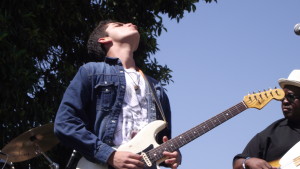
“The blues aren’t dead.” 15-year-old blues guitar prodigy Ray Goren howlin’ along with his guitar. Photo by Gary Alvarez.
Ray reminds me of why I picked up the guitar in the 7th grade—I wanted to be a rock star and slash through riffs onstage like Jimi Hendrix and Jimmy Page.
“What this kid know about the blues?” asks a gray-haired tanned man to himself while he sips a beer behind me.
“Are you not listening?” I respond.
“You got to live the blues to play the blues” the old guy snickers at me before walking away to refill his beer.
I’ve heard this opinion before: it seems some of the older generation dismiss the new as being uninformed of “genuine” music like the blues. Glancing around the main stage, I can see why some people would assume this: a majority of the attendees here are older white men with their wives and/or girlfriends and a handful of children. There are very few teenagers like Ray to be seen—and for the first time in a long time, I feel like I’m one of the youngest in the crowd.
I mention this generational gap to Ray and ask for his opinion.
“We got some great [young] musicians that are coming up. There’s a lot of amazing guitarists and singers that are into the blues besides me, so the blues aren’t dead” Ray states matter-of-factly, unfazed by others’ presumptions that this 20th century genre of music is being lost amongst millennials.
Ironically, Ray discovered the blues via YouTube when he was only 8 years old. (There goes that Internet again.) Originally a jazz piano player and influenced by that genre, he was searching for trombonist J.J. Johnson and accidentally typed in “B.B.” into YouTube’s search bar (how a simple typo can change the world!); when the search returned with music by B.B. King, Ray immediately fell hard for Blues Boy’s sound and badgered his parents to buy him a guitar for six months until they purchased one for him. Seven years later, and he’s one of the blues scene’s young rising stars.
After watching Ray perform, I’m compelled to ask what inspires him onstage to cut through riffs with the ease of Buddy Guy, with whom he played live at the age of 12.
“If I knew I would tell you—I honestly have no idea!” Ray laughs with abandon. “I just feel it. Whatever comes in the moment, I play.”
*To listen to Ray Goren: http://www.raygoren.com
Ray’s youthful energy is contagious and I walk away from his performance feeling ten years younger and ten pounds lighter, as though listening to him play lifted the weight of time from my shoulders. The blues has a certain way of uplifting me after it takes me deep down into my soul; experiencing it live is like diving into the abyss and reemerging with an immaculate pearl, breaking the water’s surface to feel the sunshine on my face.
Such are my meandering thoughts as I cruise over to the Golden Groove Stage to catch The Other Mules.
Based in Los Angeles, The Other Mules consists of the Reverend Rooster Kingfish (lead vocals/bass), Grant Cihlar (slide guitar), Todd Szabo (drums/vocals) and Kevin Merrill (lead guitar). These bluesmen dress as sharp as they play but their approach to the blues is gritty and they sound like the dangerous temptations yo’ mama warned against every time you walked out the front door.
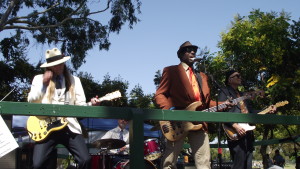
“The meaning of life is to make the world a better place than when you got here; do it through your music.”—The Reverend Rooster Kingfish, lead vocals/bassist of The Other Mules. Photo by Gary Alvarez.
“When I’m onstage I want you to feel [the blues] too. Sometimes you’ll hear me when I’m onstage saying to the band ‘Come on now, feel it!’ and they feel it—they get fired up, they get a kick in the butt. That’s what I’m talking about; this right here [breaks into song]: ‘Well, I’s goin’ down to Mississippi, yeah, got my woman standing by my side!’ That feel, that nasty grit—it’s enough to put your steel underwear on! Y’all know what I’m talking about—come on now, well all right!” Kingfish describes his creative process, drawing on inspiration from musicians as diverse as Jimi Hendrix, Bob Marley, James Brown, Elton John and Elvis Costello. And he along with The Other Mules gets the crowd jivin’, slithering like snakes in the marshes of Alabama.
“When you tour, in what condition do you observe the blues to be and where is it headed?” I ask.
“I’ve travelled all over Europe with the various bands and musicians like Barry White, Sly Stone, Maxi Priest, The Chambers Brothers and The Coasters and I’ll say this: everyone recognizes American music, whether it be blues, folk and all other genres that are derivative of that…I think in the future, because of the introduction of rap, we’re going to have to learn to embrace that too—as well as the multimedia and technology [involved with rap music]. That incorporation will take the blues into a new direction and create a new music, if you will. We have to embrace it, ‘cause that’s where it’s headed… [Through fusing blues with rap is] how we’ll bring the young people in, to recognize where the music came from. And we’ll grow from there.”
*To listen to The Other Mules: http://theothermules.com/home
Next on my agenda is Teddy Lee Hooker. His name catches my attention. I wonder if he’s related to John Lee Hooker, the legendary blues guitarist from Chicago?
Teddy’s music speaks personally of the blues in his own life. In 2003, he had open heart surgery; on another occasion, he was in an accident and broke his arm in five places. “I didn’t know if I was ever gonna play again. That was devastating for me, the fact that I wasn’t going to be able to play—I even bought a harmonica ‘cause I figured I had to do something [musically].”
Undeterred, Teddy overcame these health concerns and continues to perform all over the U.S. and in Europe in-between recording new material in his home studio. “I came back to the blues because it’s pure, it’s natural to me. Playing the guitar to me is like talking; I’m just as comfortable playing my guitar as I am talking.”
![“The thing about [the blues], you don’t have to speak the same language but you can hear what I play.”—Teddy Lee Hooker. Photo by Gary Alvarez.](https://landscapelatino.com/wp-content/uploads/2016/08/Teddy-Lee-Hooker-1-300x169.jpg)
“The thing about [the blues], you don’t have to speak the same language but you can hear what I play.”—Teddy Lee Hooker. Photo by Gary Alvarez.
“I decided to change my name because Muddy Waters, Howlin’ Wolf, all these guys had great names and I decided I needed a hook name…so I decided to change my name to Teddy Lee Hooker. It’s more of an honor of the last thing [John] said to me [after I thanked him for inspiring me]: ‘And don’t you forget it.’”
Teddy may not be related to John Lee Hooker by blood, but he continues John’s legacy in spirit. On top of that, Teddy’s stylings on the blues adds a touch of class to the sound.
*To listen to Teddy Lee Hooker: http://www.teddyleehooker.com
The only female performer scheduled for the main stage on Day 1 of the festival is Barbara Morrison. She’s a stately matriarch with a warm smile and when I meet her she hugs me like a grandmother at a family reunion.
Originally from Michigan, Barbara has been performing the blues (and jazz) since the early seventies and has played with legends such as Dizzy Gillespie, Tony Bennet and Etta James to name a few.
“I’ve had quite a journey. I started out with Eddie “Cleanhead” Vinson—who was master of the blues—around the age of 19…I toured with Johnny Otis for 21 years; that’s where I met a lot of blues greats…I circled the world a few times with [Ray Charles]…And as you know, I lost my legs to diabetes; so I’ve been walking on prostheses for a couple of years—if that ain’t the blues, I don’t know what is!” Barbara laughs, upbeat and unfazed by life’s challenges which make her successes all the more sweeter.
“What’s it like being a female vocalist in a predominantly male blues scene?” I ask.
“Are you kidding me? I’ll punch these guys out!” she jokes. But all kidding aside, Barbara holds her own among the other performers—young and old—and dominates the stage with the voice of a dozen gospel choirs booming across a vaulted cathedral. Listening to her sing is indeed better than going to church.
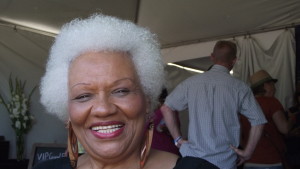
“I don’t know what everybody else is doing out there…but I’m just gonna keep on playing the blues.”—Barbara Morrison. Photo by Gary Alvarez.
The crowd responds with whooping and hollering and that’s the reason Barbara continues to perform after all these years. “I think the feeling, the way people feel when they feel my music, when they feel me, when I tell a story and they get it, [that’s what inspires me to perform]. When they can laugh with me, they can cry with me, they understand [what I’m singing about]. When the ladies come up to me and ask ‘How did you know [what I’m going through]?’ and a man comes up to me and says ‘You’re responsible for this!’ and shows me a two-year-old boy! [laughs] That keeps me inspired.”
*To listen to Barbara Morrison: http://www.barbaramorrison.com
Day 2: Sunday, September 6th
I arrive a little later the next morning. No need for me lallygagging around the festival grounds before noon. It’s too hot for that and one thing I’ve learned about attending music festivals is to pace myself, so I make a list of the bands I want to see and time them accordingly.
The Delgado Brothers are at the top of my list on day 2, but they’re not scheduled till 2pm so I stroll over to the Golden Groove Stage in the hopes of catching an up-and-coming band. It is here that I meet South River Slim, a Canadian who digs his blues fused with dirty rocknroll—just like I do.
As I approach the stage, I hear him covering Slim Harpo’s “Hip Shake” and notice that his harmonica player is wearing a T-shirt with a picture of 70s Keith Richards playing guitar on it. Kindred spirits, I smile to myself. Accompanying the two is a guitarist who’s strumming while sitting down, kicking a bass drum with one foot and stomping on a tambourine with the other.
Slim leaps off the small stage as the backing duo medleys into the Stones’ “Midnight Rambler” and he starts singing into the mic as if it’s the woman in the song’s lyrics—all the while whipping the pavement with a leather belt. Quite the showman, South River Slim turns out to be.
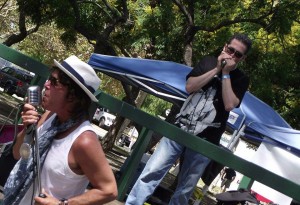
“It’s like breeze and air and colors, like adding sound to a big sheet of silence.”—South River Slim, describing his sound. Photo by Gary Alvarez.
“Where’d you get the name South River Slim?” I ask.
“I was born in South River, Ontario [Canada]. And when I got sick [from cancer] I went back to where I’m from…Right now I’m in remission…So that’s what gave me the blues, big time. That’s kind of when I became South River Slim. I was at death’s door and music saved me. I was listening to [the blues] and thinking about it and thought, if I can only get out of this I’m gonna do what I wanna do instead of just doing it here and there, so I decided to pursue it more passionately.”
There’s a sense of urgency in Slim’s voice as we speak as well as in his performance, as if there may be no tomorrow and right now is all he has. From the depths of loneliness where death seems imminent, Slim has found a flicker of light in the blues and he wants to shine that light on his audience.
“I turned those bad things into something good that works for me” he adds before wrapping up his interview. “Six months from now, I’m gonna have a release out. A new album of originals.”
*To listen to South River Slim: https://southriverslim.bandcamp.com
I take leave from Slim and head to the main stage for The Delgado Brothers. I’m interested in hearing them perform primarily because of their Spanish surnames. After all, I’m covering this festival for Landscape Latino—an online publication whose primary audience is, you guessed it, Latinos—and I’m trying to make a connection between blues music and the Latino community. It’s a tough one to make, considering Latino’s aren’t traditionally known to be blues enthusiasts. Not that Latinos are strangers to the blues of life—the struggles, the heartaches, that low-down grinding feeling—but as an audience Latinos tend to listen to other genres of music in order to relate to those experiences.
So I turn to The Delgado Brothers for a connection; but as it turns out, for Steve Delgado—who plays drums in the band—it doesn’t matter what neighborhood you’re from, the blues is the blues. “I think it’s all about how you feel, what you feel, how you play your music and how it comes across. It doesn’t matter what kind of music it is. If it’s real, good and solid and from love, you can’t go wrong.”
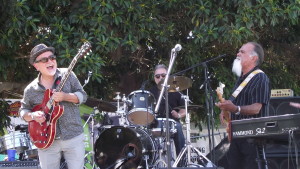
“The blues comes from the heart…Everything we talk about and sing about, it’s what’s for real.”—Steve Delgado, drummer of The Delgado Brothers. Photo by Gary Alvarez.
As I look behind me at the crowd—and around me during both days of the festival—I notice there aren’t many Latinos in attendance, but there’s enough color to go around. And the common color is the blues. That’s the one color that doesn’t discriminate.
*To listen to The Delgado Brothers: http://www.delgadobrothers.com
After The Delgado Brothers finish their set, they return to the stage as the backing band for the most soulful performer of the festival—for me, at least: Sherry Pruitt.
Sherry infuses a heavy dose of soul into the blues she belts, which she credits to an experience she had while watching one of her favorite singers on television during her teens. “I started singing when I was 15 years old. I saw Aretha Franklin on the Ed Sullivan Show, and that’s the moment when I knew that’s what I wanted to do…So when I saw her, something above me said ‘That’s what I want you to do.’ And I’ve been doing it ever since.”
When Sherry describes her role in music, she sounds more like a missionary than just an ordinary blues singer. “I’m just gonna keep sharing and keep traveling, recording, going wherever the Spirit takes me. That’s my main goal: keep spreading the Word and keep spreading the Love.”
There’s a whole lotta love in Sherry’s performance—broken love, healing love, love to be—and it’s enough to keep the crowd moving, at least just for today.
*To listen to Sherry Pruitt: http://www.sherrypruitt.com
Later in the afternoon I run into Kid Ramos as he’s greeting family, friends and fans backstage. Today he received an award for his contributions to the blues and he’s getting hugs from everybody.
“What got you into the blues?” I ask.
“I had an older brother that brought home records. I started playing them and I enjoyed it…something about the blues spoke to me.”
One thing in common that Kid Ramos has with almost all the other musicians I spoke with is a connection to the blues at an early age.
“What words of wisdom would you share with younger musicians interested in the blues?”
“I would say listen to the roots, man. Go back and build a foundation, listen to the founders. Once you got a good foundation, you can build a house. But you gotta learn the basics from the original guys. Get that stuff and go from there.”
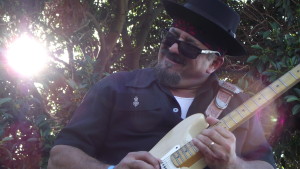
“I just to play from the heart, that’s basically it. I’m not interested in the notes so much as the feeling that’s inside.”—Kid Ramos performing with The 44’s. Photo by Gary Alvarez.
*To listen to Kid Ramos: https://kid-ramos.band-findr.com/music
As the sun begins to set over El Dorado Park, New Blues Revolution hits the stage. Fronted by singer/songwriter William “Bill” Grisolia, the band named itself in solidarity with the new blues sound that partly inspired this festival to begin initially. Bill is also the New Blues Festival’s producer.
“The new blues revolution is akin to the boom of the British blues in the late 60s and early 70s that was triggered by bands like Led Zeppelin and The Rolling Stones” Bill explains during an interview after the festival. “[It was led by musicians who were into] de-tuning their instruments, trying to be in blues bands, playing the American deep blues. So this new blues movement—about a decade old—is a contemporary version of trying to do the deep blues but in a more modern context.”
This new blues revolution is gaining momentum in England, Czechoslovakia and Australia. Bill cites bands like The Black Keys and The White Stripes as examples of bands who are at the vanguard of this new incarnation of the blues sound in America and includes his own band in “leading the charge, doing a very similar thing…doing a new take on the deep blues that’s more contemporary.”
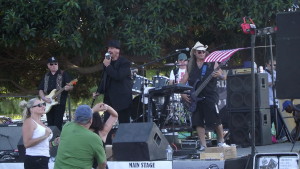
“What we’re trying to do is honor the past, honor the traditions and introduce the new.” William “Bill” Grisolia, vocalist for New Blues Revolution and producer of the New Blues Festival. Photo by Gary Alvarez.
Although the first New Blues Festival was initiated in 2014, live blues in a festival setting in Long Beach has a tradition that goes back over 35 years. In 1980, local jazz radio station KLON (now known as KKJZ) launched the original Long Beach Blues Festival that ran until 2009, when a payola scandal led to the dissolving of the radio station’s board of directors. “The new board of directors for the radio station brought in a new management company that brought in a new producer who wasn’t really interested in developing sponsorship opportunities to do the festival. They tried a couple of times to do something called The Blues Blast. They couldn’t call it a blues festival. The Blues Blast, the first year was held in the parking lot of the Carpenter Center [at Cal State University Long Beach] and also in the Carpenter Center itself. They did something in the afternoon and something in the evening. And that didn’t work out very well because nobody likes to be on hot asphalt, people want grass, ‘cause that’s what makes it a festival. People want grass and lawn chairs. If you don’t have grass and lawn chairs, it’s not a festival—that’s the world according to Bill,” Grisolia elaborates with a laugh.
At El Dorado Park, there’s plenty of grass to sit on—and to smoke, ‘cause let’s face it, it wouldn’t be a blues festival without the smell of herb occasionally wafting above the music. Note: the New Blues Festival prides itself as being family friendly. But this is America; to each his own.
So what’s in the future for the New Blues Festival?
“The plan is to continuously improve the quality of the production aspects. In terms of the talent, we intend to engage national acts and international acts” Bill shares with a promising twinkle in his eye. “We’ve already set that bar and we’re hoping to improve—to get more performers of high caliber. As well as bringing the youth.”
*To listen to New Blues Revolution: http://www.newbluesrevolution.com
As the Long Beach Blues Festival II comes to a close, I walk back to my space pod thinking about all the great live music I’ve heard over that last 48 hours. It’s been a sensory overload that leaves my skin tingling.
There was more than a lifetime of blues on these stages and in the audience. They remind me that no matter the heartache, the headaches, the struggles—in the end it’s gonna be alright, ‘cause we all get ‘em, we all feel the blues.
And if you don’t feel the blues, you ain’t done ‘nough living.
*Thanks to Christian Garduno for the feedback.
For info on the New Blues Festival III, visit the webpage: http://www.newbluesfestival.com/
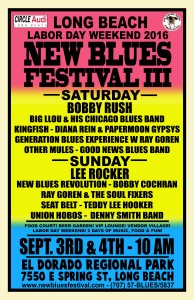
The New Blues Festival III is going down this Labor Day weekend, September 3rd & 4th 2016 at El Dorado Park in Long Beach, CA.

